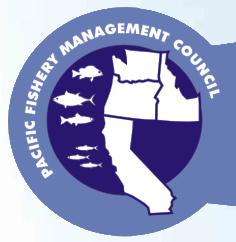 Pacific Fishery Management Council chooses options for 2009 salmon season: fisheries in north improve; Fisheries in south still limited
Pacific Fishery Management Council chooses options for 2009 salmon season: fisheries in north improve; Fisheries in south still limited
Seattle, Wa. – The Pacific Fishery Management Council today adopted three public review options for the 2009 salmon season off the West Coast of the United States. The Council will select a final option at their next meeting in Millbrae, California on April 5-9. California and southern Oregon (south of Cape Falcon) Sport season options California ocean sport fishing options range from entirely closed to 10 open days in August and September in the Eureka/Crescent City area.
Oregon ocean recreational options include mark-selective coho fishing seasons starting in June or July and running into September. One of those options includes a three fish daily bag limit to take advantage of a large abundance of hatchery coho. Options for Oregon ocean Chinook fishing in the Brookings area range from closed to open for 10 days in August and September. For the Tillamook, Newport, and Coos Bay areas, seasons range from closed to open in September. Commercial season options Commercial ocean salmon fishing will be closed in California in 2009. Oregon season options in the Brookings area range from closed to a season with a 1,000 Chinook quota in September. Season options in the Tillamook, Newport, and Coos Bay area range from closed to open for Chinook and coho in September, with quotas on coho catch.
Background for area south of Cape Falcon
In 2008, poor Sacramento returns led to the largest fishery closure on record. While this year’s returns are better than last year’s, the season options are still limited. Without any fishing, 122,196 fish are expected to return to the Sacramento River this year. The minimum conservation goal is 122,000 – 180,000 spawning adult salmon1
North of Cape Falcon, Columbia River hatchery coho returns were about double the . In April, a multi-agency task force is expected to report on the causes of the Sacramento salmon decline. Also in California, Klamath River Fall Chinook are forecast to meet the minimum natural spawning goal of 35,000, and the 2009 management objective of 40,700. Oregon coastal coho had much better returns in 2008 than forecast, with a total of 165,700 natural spawners. This was the best return in four years and the fifth best since at least 1970. Northern Oregon and Washington (north of Cape Falcon) Sport season options Ocean sport fishery options north of Cape Falcon in Oregon and off the Washington coast have mark-selective coho quotas ranging from 168,000 to 189,000 that start in late June or July and run into September. The 2009 coho quota options are eight to nine times the 2008 quota.
Chinook fishing will also be allowed, but in the Columbia River and Westport areas, one option only allows marked hatchery Chinook to be kept. Commercial and tribal season options Non-Indian ocean commercial fishery options north of Cape Falcon include traditional Chinook seasons in the May-June time frame. In the July to September time frame, options range from seasons than run continuously, to seasons with various closed times and areas, and gear restrictions to target primarily pink salmon. Chinook quotas for all areas and times range from 10,000 to 22,500, which are similar to the 2008 quota of 20,000. The coho quotas range from 32,000 to 36,000, eight or nine times the 2008 quota.Tribal ocean fisheries north of Cape Falcon are similar to recent years, although coho quotas are much larger than in 2008. Background for area north of Cape Falcon
The conservation goal, or escapement goal, is the optimal number of adult fish returning to spawn in order to maximize the production of the stock.
2008 forecast (472,000). Columbia River Chinook returns were also better than forecast. The 2009 Columbia River tule Chinook forecasts are similar to 2008 forecasts. The hatchery coho forecasts for the Columbia River are the best since about 2001. In addition, the forecast for Oregon coastal natural (OCN) coho is improved over 2008, and is the second highest forecast since 1996. Management Process Public hearings to receive input on the options are scheduled for March 30 in Westport, Washington and Coos Bay, Oregon; and for March 31 in Eureka, California.
The Council will consult with scientists, hear public comment, and revise preliminary decisions until it chooses a final option at its meeting during the week of April 5 in Millbrae, California. At its April 5-9 meeting in Millbrae, the Council will narrow these options to a single season recommendation to be forwarded to National Marine Fisheries Service (NMFS) for their final approval before May 1. All Council meetings are open to the public. Press Packet and Briefing Materials Available A press packet with contacts, background information, a map of affected areas, and acronyms is available on the Council website at the link below.
Council Role The Pacific Fishery Management Council is one of eight regional fishery management councils established by the Magnuson Fishery Conservation and Management Act of 1976 for the purpose of managing fisheries 3-200 miles offshore of the United States of America coastline. The Pacific Council recommends management measures for fisheries off the coasts of California, Oregon, and Washington.
###
On the Web
• Pacific Fishery Management Council: http://www.pcouncil.org
• Options for 2009 salmon management (to be posted when finalized): http://www.pcouncil.org/salmon/salpre09.html
• Online press packet: http://www.pcouncil.org/newsreleases/sal_presspacket2009.html
• Geographical points used in salmon management: http://www.pcouncil.org/facts/geosalmon.pdf
• Explanation of common terms used in salmon management: http://www.pcouncil.org/newsreleases/salmon_packet/Common_Terms.pdf
Disclaimer: Articles featured on Oregon Report are the creation, responsibility and opinion of the authoring individual or organization which is featured at the top of every article.


